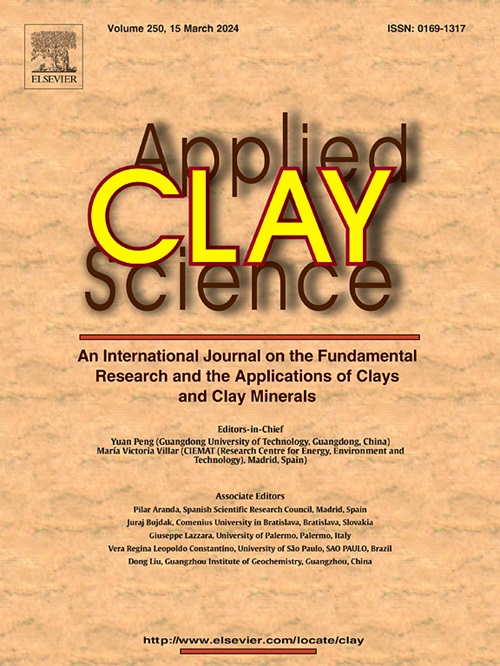Synergistic effect of processing water treatment sludge rich in kaolinite for the sustainable production of LC3
IF 5.3
2区 地球科学
Q2 CHEMISTRY, PHYSICAL
引用次数: 0
Abstract
The increasing population and urban development intensify the need for potable water, resulting in higher production of sludge in water treatment plants (WTPs). To mitigate the improper disposal of sludge and reduce carbon dioxide emissions from Portland cement production, the pozzolanic activity of sludge and its ashes, derived from WTPs and referred to as WTPA, is being investigated. These materials are being evaluated as supplementary cementitious materials (SCMs), enabling their application in the development of limestone calcined clay cement (LC3). The WTPA samples calcined at 600, 700, and 800 °C were analyzed using X-ray fluorescence (XRF), X-ray diffraction (XRD), thermogravimetric analysis (TGA), scanning electron microscopy (SEM), Brunauer-Emmett-Teller (BET) surface area analysis, Blaine fineness, and laser diffraction techniques. Compressive strength, electrical conductivity, and R3 tests were performed to evaluate pozzolanic reactivity of WTPA. The influence of calcination temperature, the proportion of WTPA, and the water/cement ratio were studied using the Box-Behnken design in LC3 mixtures. The results suggest that the calcination temperature of 700 °C is ideal for producing pozzolana, standing out with an SAI of 140 % and 19.09 MPa in the lime test. This temperature also favored a higher combined water content (15.8 g/100 g of paste), indicative of resistant hydrated compounds. Additionally, the multi-objective analysis indicated that the optimal formulation for WTPA use in LC3 involves a calcination temperature around 700 °C, a replacement rate of 17.62 %, and a water/cement ratio of 0.54. This formulation provides a fluid consistency, while compressive strength reaches 35.57 MPa, demonstrating the effectiveness of sludge as pozzolana. This study provides new insights into the use of water treatment plant sludge ash as a sustainable material for the development of LC3, offering a promising alternative to reduce the environmental impact of the cement industry.

富高岭石水处理污泥对LC3可持续生产的协同效应
不断增长的人口和城市发展加剧了对饮用水的需求,导致水处理厂(WTPs)的污泥产量增加。为了减轻污泥的不当处置和减少波特兰水泥生产中的二氧化碳排放,目前正在调查来自污水处理剂(WTPA)的污泥及其灰烬的火山灰活性。这些材料正在被评估为补充胶凝材料(SCMs),使其能够应用于石灰石煅烧粘土水泥(LC3)的开发。采用x射线荧光(XRF)、x射线衍射(XRD)、热重分析(TGA)、扫描电镜(SEM)、布鲁瑙尔-埃米特-泰勒(BET)表面积分析、布莱恩细度和激光衍射技术对600、700和800℃煅烧的WTPA样品进行了分析。通过抗压强度、电导率和R3测试来评价WTPA的火山灰反应性。采用Box-Behnken设计研究了煅烧温度、WTPA掺量和水灰比对LC3混合料的影响。结果表明,在700℃的煅烧温度下生产灰火山灰较为理想,在石灰试验中,SAI为140%,MPa为19.09 MPa。这个温度也有利于更高的复合含水量(15.8 g/100 g),表明具有抗性的水合化合物。此外,多目标分析表明,WTPA在LC3中使用的最佳配方为煅烧温度约700℃,替代率为17.62%,水灰比为0.54。该配方具有流体一致性,抗压强度达到35.57 MPa,证明了污泥作为灰火山灰的有效性。本研究为利用水处理厂污泥灰作为LC3的可持续发展材料提供了新的见解,为减少水泥工业对环境的影响提供了一个有希望的替代方案。
本文章由计算机程序翻译,如有差异,请以英文原文为准。
求助全文
约1分钟内获得全文
求助全文
来源期刊

Applied Clay Science
地学-矿物学
CiteScore
10.30
自引率
10.70%
发文量
289
审稿时长
39 days
期刊介绍:
Applied Clay Science aims to be an international journal attracting high quality scientific papers on clays and clay minerals, including research papers, reviews, and technical notes. The journal covers typical subjects of Fundamental and Applied Clay Science such as:
• Synthesis and purification
• Structural, crystallographic and mineralogical properties of clays and clay minerals
• Thermal properties of clays and clay minerals
• Physico-chemical properties including i) surface and interface properties; ii) thermodynamic properties; iii) mechanical properties
• Interaction with water, with polar and apolar molecules
• Colloidal properties and rheology
• Adsorption, Intercalation, Ionic exchange
• Genesis and deposits of clay minerals
• Geology and geochemistry of clays
• Modification of clays and clay minerals properties by thermal and physical treatments
• Modification by chemical treatments with organic and inorganic molecules(organoclays, pillared clays)
• Modification by biological microorganisms. etc...
 求助内容:
求助内容: 应助结果提醒方式:
应助结果提醒方式:


